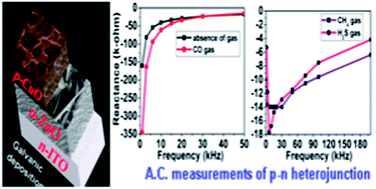Electrochemical synthesis of p-CuO thin films and development of a p-CuO/n-ZnO heterojunction and its application as a selective gas sensor†
Abstract
p-CuO thin films have been synthesized on indium tin oxide (ITO)-coated glass substrates and on ZnO/ITO-coated glass substrates using a new, simple, cost-effective electrochemical technique (galvanic deposition) at room temperature. X-ray diffraction (XRD) studies of the films show a monoclinic phase of CuO, and UV-vis spectroscopy of the CuO/ITO film shows an indirect band-gap energy of about 1.85 eV. The surface morphology of CuO thin film consists of a c-axis-grown regular macroporous network structure with deep cavities surrounded by thin solid walls, which are suitable for gas trapping and sensing. Current–voltage characteristics of the formed p-CuO/n-ZnO film show good rectifying behavior. At 1 V reverse bias, the leakage current was as low as 2 × 10−9 A compared to a current of 1.2 × 10−7 A at the same forward bias, resulting in a forward-to-reverse current ratio of about 60. The ideality factor of the diode obtained was quite high, at about 9.5. The frequency dependence of the small signal AC response in both Rp–Cp and Rs–Cs mode of the fabricated heterojunction were measured at a reverse bias of 1.5 V. In the presence of 10 000 ppm gas exposure for gases, including CH4, H2S and CO, frequency-dependent changes in AC responses are different for different gases. The variation of the reactance of the fabricated device shows different behaviour with exposure to different types of gases. The minimum in reactance occurring at different frequencies for different gases indicates the selectivity of the device for gas sensing.


 Please wait while we load your content...
Please wait while we load your content...